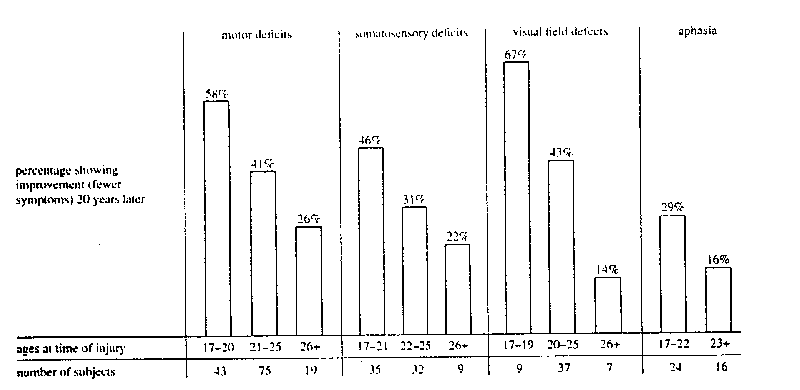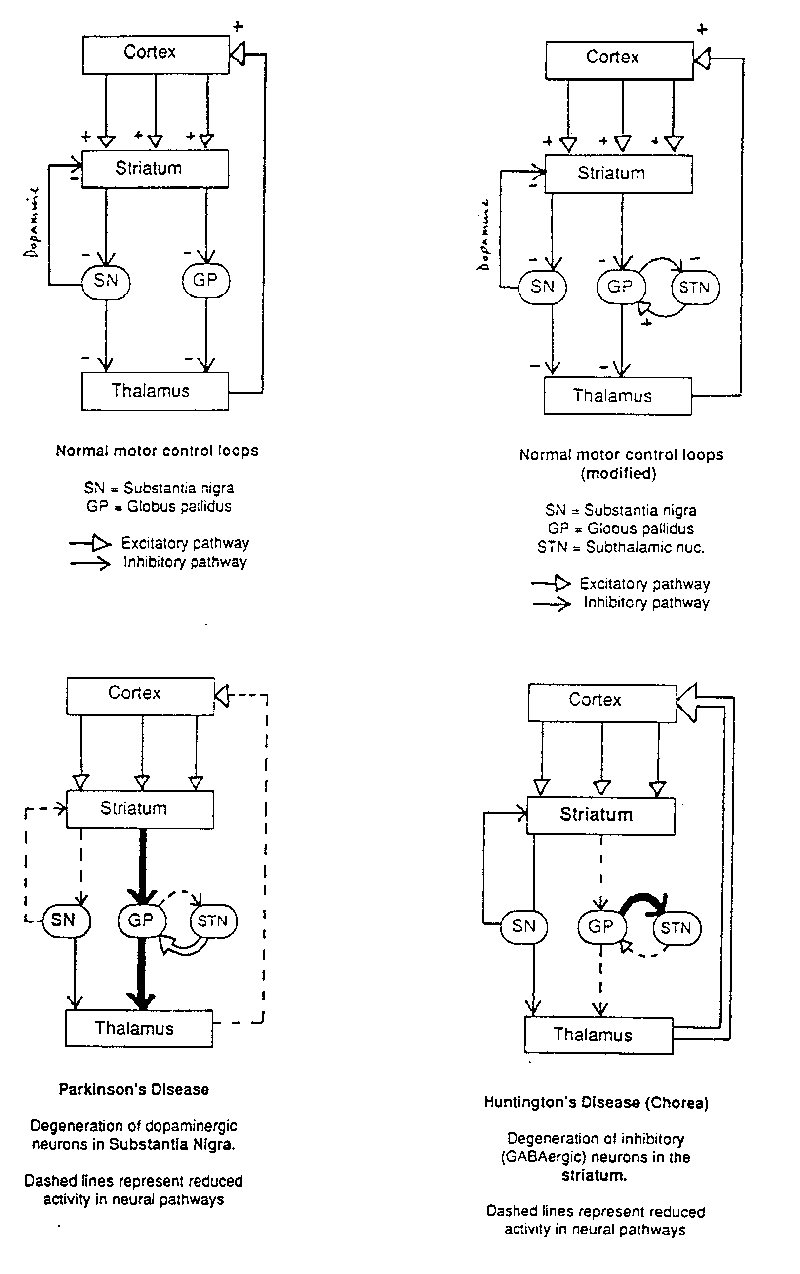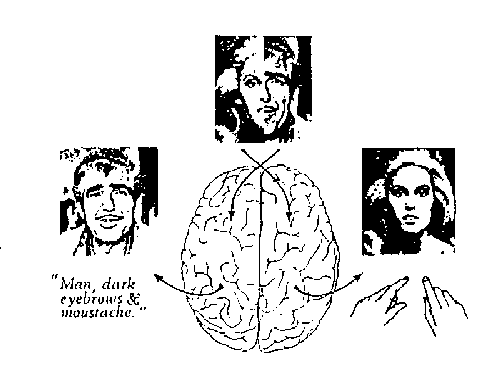SD206 Tutorial 6
Revision notes on BRAIN FUNCTION & DISEASE (Book 6)
Back to Tutorial 6
or Back to BBB Home page
Biology of neurological disease (§5.2)
Pathological causes of brain disease:
Vascular e.g. stroke (haemorrhage or thrombosis)
Trauma e.g. head injury
Epilepsy
Infections e.g. encephalitis, meningitis
Toxins e.g. alcohol, heavy metals
Tumours primary or secondary
Degeneration e.g. Alzheimer's disease
Developmental e.g. Down's syndrome, hypothyroidism
Recovery (§5.3)
Although central nervous tissue does not regenerate, some degree of recovery
from brain disease may occur.
The extent depends on the type and extent of lesion, its duration and
the age it occurs.
Recovery is best in the young, when some plasticity remains (i.e. during
a sensitive period).
This may be take the form of axonal sprouting, unmasking of 'silent'
synapses or structuring of pathways (e.g. 'taking over' areas that are
'uncommitted').
The Figure below (p 147 of Book 6) shows that for injuries to different
areas of the brain, the extent of recovery is greatest the younger the
age at time of injury. Recovery is best for visual field defects, followed
by motor deficits, then somatosensory deficits, whilst there is least recovery
with dysphasias.
The figure shows the estimated improvement between the time of the
initial examination made (within one week of injury) and follow-up examination
(20-30 years later) for motor, somatosensory, visual field and aphasia
deficits, broken down by age at time of injury.

Aetiology of neurological disease ( §4.1, 4.2):
| Genetic disorders |
Environmental causes |
| Chromosomal: Down's syndrome |
Infections |
| Genes: |
Toxins: |
Huntington's chorea
Lesch-Nyhan's disease
|
alcohol,
lead,
mercury
|
|
|
Basal ganglia disorders (§4.3)
Basal ganglia play a major role in initiating movements and in switching
from one movement to another.
There are complex feedback control circuits between
the BG and the motor cortex via the thalamus.
Damage to these pathways can result in disordered movement, which may
involve excessive movement (hyperkinetic) or diminished movements (hypokinetic).
Hypokinetic states:
e.g. Parkinson's disease
Resting tremor rigidity
slowness and lack of 'gestures/expression'
Degeneration of dopamine neurons in nigro-striatal pathwav
drug treatment: L-DOPA
transplants: sources of
viable dopaminergic cells
adrenal medulla autografts
foetal substantia nigra
Hyperkinetic states
e.g. Huntington's chorea (Gr. chorea=dance)
excessive, uncoordinated movements of body
runs in families, and now establishes as due to abnormal gene
Depletion of GABA neurons in striatum (caudate nucleus)
Aetiology
|
Parkinson's |
Huntington's |
| Genetic basis |
No evidence |
Yes, single gene disorder |
| Age at onset |
40-50 |
15 + (30-50 mainly) |
What 'triggers'these diseases which often begin in middle age?
Attempts have been made to implicate various external factors, such
as certain toxins, but no clear associations have been found. It is not
known why some people are somehow more susceptible to these disorders.
Neural mechanisms of Parkinson's and Huntington's diseases:
(§4.3.2)
The diagrams below attempt to summarise the role of the Basal Ganglia in
motor control, and how the normal control mechanisms are disrupted in Parkinson's
disease and Huntington's disease. The diagrams are based on Figures 4.6,
4.9 and 4.10 in Book 6, but are modified to include an extra 'loop' involving
a small but important part of the basal ganglia the subthalamic nucleus,
which is not mentioned in Book 6. This is added to explain how increased
inhibition from the striatum to the globus pallidus can cause an increased
output from the globus pallidus (e.g. see Fig 4.10).
This is admittedly small print stuff, but many students have asked about
this apparent paradox.
Localization of cerebral functions (Ch 6)
Evidence based on nature and extent of functional deficits following localized
brain damage (lesions).
The extent of localization of function depends on interpretation of
evidence.
Localisation of function (differences within hemispheres)
Clinical evidence; Penfield's experiments with focal stimulation
Neocortex: different functional areas of the cortex e.g.
Primary motor cortex, somatosensory cortex, visual cortex, auditory
cortex, olfactory areas.
Broca's and Wernicke's areas for language: evidence from studies of
dysphasia.
(N.B. language functions are not 'localised' to one small area: many
areas function together, each making a unique contribution to overall language
function.
Temporal lobe and hippocampal involvement in memory:
Here, different regions serve different aspects of memory.
(Penfield - localised (episodic memories); Lashley - diffuse location
of memory for running a maze)
Lateralisation of function (differences between hemispheres)
Right/left hemispheric differences (not mere mirrors of each other)
Each hemisphere controls function of the contralateral side of body
Concept of dominant / non-dominant hemispheres
But the 'dominant' hemisphere does not 'dominate' the other one. Hence
alternative names:
Categorical ('dominant')
hemisphere
Representational ('non-dominant')
hemisphere
Left hemisphere is language-dominant in majority of people: 90% of right-handers
and 65% of lefthanders.
Left hemisphere: verbal abilities; right hemisphere: spatial ones
Left hippocampus: verbal memories; right hippocampus: non-verbal (spatial)
memories.
Evidence from 'split brains' (§6.3.1)
Subjects with complete division of the corpus callosum. and thus
no neural connections between the right and left hemispheres reveal something
of the functional capabilities of 'isolated' cerebral hemispheres.
A 'split-brain' patient is shown a brief glimpse of a split picture
(using a tachistoscope), such that a different image is presented to each
visual field, and thus to each half of the brain. When asked what (s)he
saw, the patient says (the left hemisphere talking), "Man..". But if asked
to point out the observed picture from a selection, the patient
invariably
points to the one seen by the 'silent' (right) hemisphere. Thus, the right
hemisphere is not under the 'yoke' of the 'dominant' left, but can express
its 'thoughts' if allowed to do so. (But is this evidence for two independent
minds ?)
Back to Tutorial 6
or Back to BBB Home page




